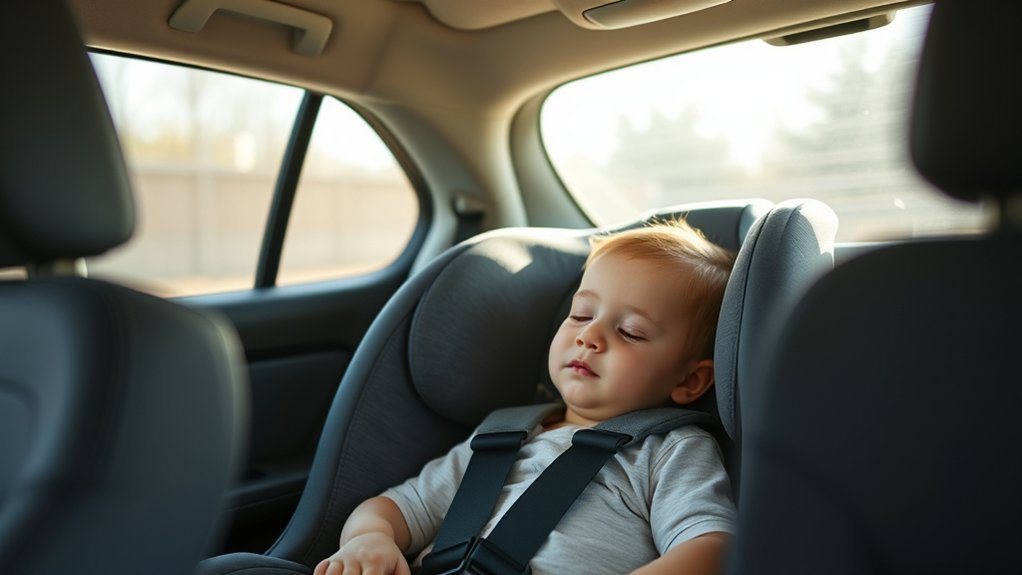Ensuring your child’s safety while they sleep in a car seat is crucial for any parent. It starts with selecting the right car seat tailored to your child’s specific needs. Once you have that, proper installation and monitoring become essential. This guide will walk you through these key steps, allowing you to travel with confidence. But what about those tricky moments when it’s time to shift them to their crib?
Understanding the Importance of Car Seat Sleep Safety
When you’re on the road with your little one, understanding car seat sleep safety is essential to guarantee their well-being.
Babies and toddlers often doze off during drives, but it’s important to make sure they’re safe while sleeping. Proper car seat use minimizes risks, preventing injuries in case of sudden stops or accidents.
Always secure your child in a rear-facing seat, which offers the best protection for their developing neck and spine. Monitor their position; slumping can lead to breathing difficulties.
Avoid using bulky coats or blankets that can interfere with the harness. Remember, while it’s tempting to let your child sleep in their seat for convenience, prioritizing their safety will empower you both on every journey.
Choosing the Right Car Seat for Your Child
How do you know which car seat is best for your child? Start by considering their age, weight, and height. Infants typically require rear-facing seats, while toddlers may shift to forward-facing options.
Confirm the car seat meets safety standards; look for labels indicating compliance with federal regulations. Additionally, check the seat’s expiration date, as materials can degrade over time.
You should also evaluate ease of use—look for features like adjustable straps and easy installation systems.
Finally, consider your vehicle’s compatibility; not all car seats fit every car. Research reviews and seek recommendations from trusted sources. Choosing the right car seat empowers you to keep your child safe and comfortable during every journey.
Proper Installation and Positioning of the Car Seat
Ensuring your car seat is properly installed and positioned is essential for your child’s safety during travel.
Start by reading the manufacturer’s instructions carefully, as each model may have specific requirements. Position the car seat in the back seat, ideally in the center, away from side airbags. Use the seatbelt or LATCH system to secure it tightly, ensuring there’s no more than an inch of movement at the base.
For infants, keep them rear-facing until they reach the maximum weight or height limit specified. Adjust the harness so it fits snugly, with the clip at armpit level.
Regularly check the installation, as it can shift over time. Doing this guarantees your little one travels securely and comfortably.
Monitoring Your Child While They Sleep in the Car
While your child may look peaceful as they sleep in the car, it’s crucial to keep an eye on them for safety’s sake. Regularly check on them through the rearview mirror to verify they’re comfortable and secure.
Avoid distractions; your focus should remain on the road and your child’s wellbeing. If you’re traveling alone, consider using a baby monitor with video capability to stay connected.
Pay attention to the temperature inside the car; make sure it’s neither too hot nor too cold. If you stop for any reason, don’t leave your child unattended, even for a moment.
Transitioning From Car Seat to Crib: Best Practices
As your child drifts off to sleep in the car, it’s essential to plan a smooth movement from the car seat to the crib for their safety and comfort.
Start by ensuring your child is in a deep sleep before moving them. Gently unbuckle them, supporting their head and neck. Keep the environment calm and quiet to avoid startling them.
If possible, use a lightweight blanket to maintain warmth during the transfer. Place them in the crib carefully, laying them down on their back.
Once settled, consider softly patting or shushing them to reinforce a sense of security. By following these steps, you can help your child move safely, fostering peaceful sleep in their crib without disruption.
Frequently Asked Questions
Can My Child Sleep in a Car Seat Outside of the Car?
No, your child shouldn’t sleep in a car seat outside of the car. It’s unsafe and can lead to respiratory issues. Always prioritize a flat, safe surface for sleep to guarantee their well-being.
How Long Can a Child Safely Sleep in a Car Seat?
Your child can safely sleep in a car seat for about 30 minutes to an hour. For instance, during a long road trip, monitor them closely to prevent slouching or airway obstruction while they rest.
What Should I Do if My Child Falls Asleep in the Car?
If your child falls asleep in the car, gently monitor them. When possible, transfer them to a safe sleeping environment, ensuring they’re comfortable. Always prioritize their safety and well-being over convenience during travel.
Are There Specific Sleep Positions to Avoid in a Car Seat?
Yes, you should avoid allowing your child to sleep slumped forward or with their head hanging down in a car seat. These positions can restrict airflow and increase the risk of suffocation or discomfort.
Does the Car’s Temperature Affect Car Seat Sleep Safety?
Just like Goldilocks found her perfect porridge, the car’s temperature needs to be just right. Too hot or cold can disrupt your child’s sleep and pose safety risks, so always aim for a comfortable climate.
Conclusion
In conclusion, prioritizing car seat sleep safety is like building a sturdy bridge to guarantee your child’s well-being during travel. By choosing the right car seat, installing it properly, and monitoring your child, you create a secure environment for peaceful rest. When it’s time to shift to the crib, doing so with care helps maintain that safety. Remember, every small step you take contributes to your child’s safety, allowing you both to travel with confidence and peace of mind.
